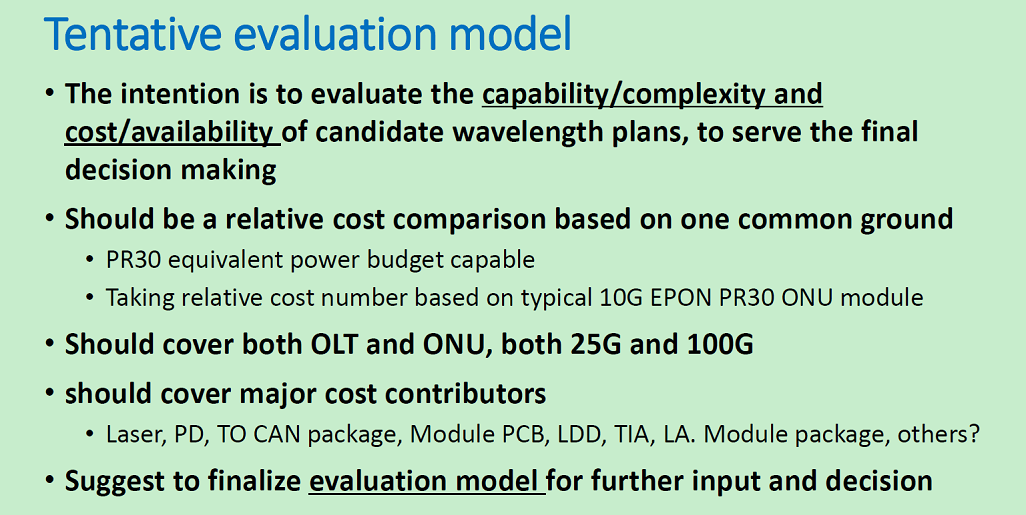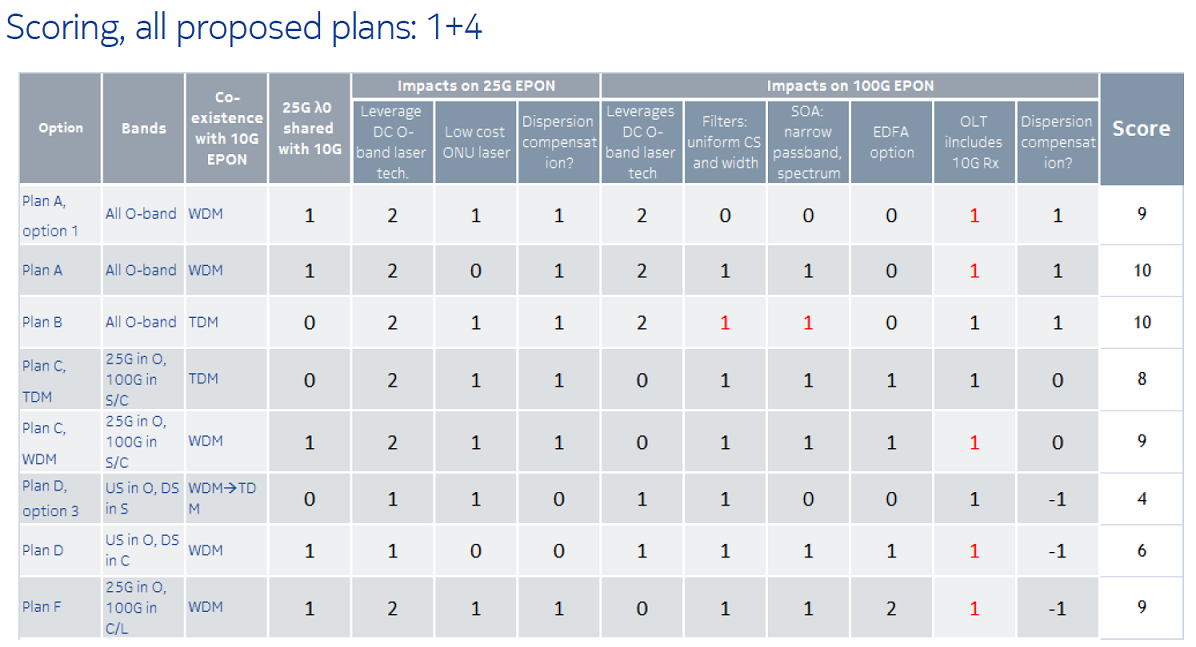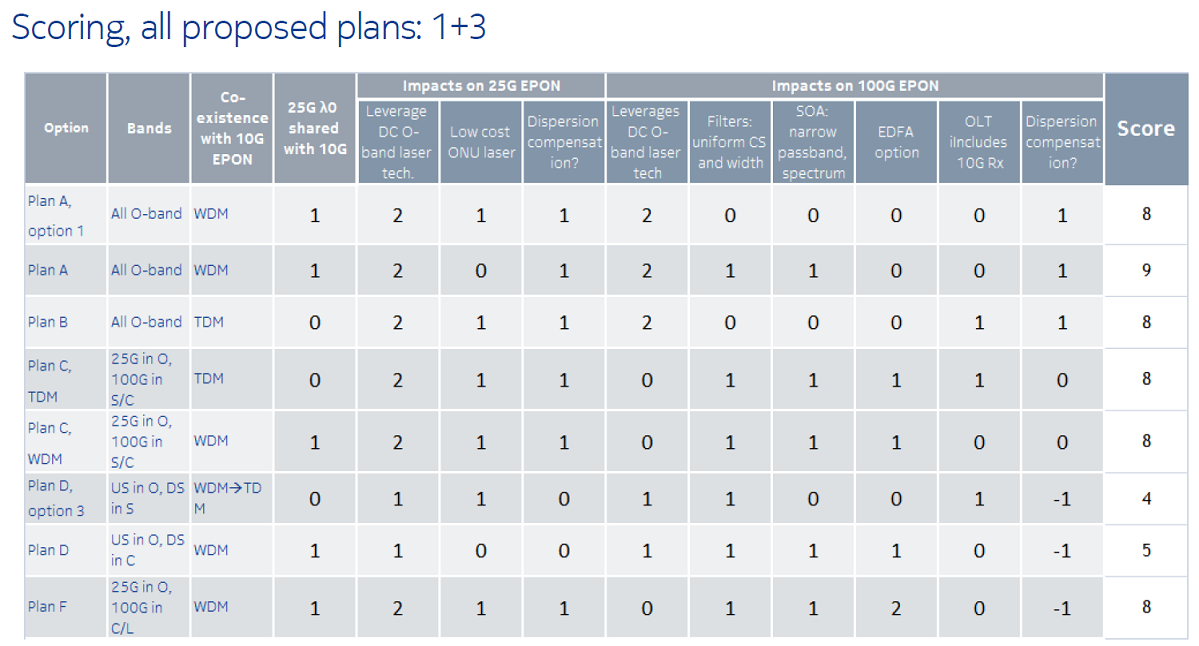John,
Good thoughts, see my responses in-line.
Ed
From: John Johnson [mailto:john.johnson@xxxxxxxxxxxx]
Sent: Friday, October 28, 2016 10:55 AM
To: Harstead, Ed (Nokia - US) <ed.harstead@xxxxxxxxx>
Cc: STDS-802-3-NGEPON@xxxxxxxxxxxxxxxxx
Subject: Re: [802.3_NGEPON] Proposed weighting of criteria for wavelength plan comparison model
Ed,
Thank you for continuing to refine the value criteria for comparison of wavelength plans. I hope that this will guide us to a decision at the Nov. meeting. I have a few comments and questions,
mostly pertaining to the choice of WDM vs TDM coexistence. It's my view that the choice of which is better is to a large extent independent of the wavelength plans. If the impact of TDM on 25/50/100G US capacity is determined to be not too significant, then
most of the plans that assumed WDM coexistence was more desirable can be adapted to TDM and benefit from further advantages such as uncooled DML for 25/25G ONU and more spectrum for 100G channels. The cost of TDM capacity reduction must be determined before
we start applying it as a criteria for wavelength plan selection.
[Ed Harstead] Completely agree. Plans A (WDM) and B (TDM) are otherwise basically the
same. Plan C has both TDM and WDM options. Plan D is WDM but could easily be adapted to TDM.
I will bring a contribution summarizing the pros and cons of TDM vs. WDM co-existence.
Maybe others will also bring their viewpoints. That would be a good discussion to have before we make wavelength plan decisions.
Comments on the criteria:
- It's possible to route two separate O-band wavelengths for 10G and 25G to the same dual-rate RX if that is a lower cost solution than separate 10G and 25G RX, making this more of an implementation
choice. Since all the plans being considered have US0 in O-band, what distinction is this criterion making? Whether this approach is possible for 100G OLT depends on the wavelength plan details so it is still a valid criterion for 100G OLT.
[Ed Harstead] I think you are referring to the criterion “OLT does not require a 10G
Rx”, and it’s a great point that a dual rate receiver could be implemented for the WDM co-existence scenario. But for Plans A and D, it appears to me that you would require a very sharp filter at the 25G OLT (40 nm wide but then slice between two channels
800 GHz apart). Would that be a practical implementation (compared to a separate 10G receiver)?
- You have two criteria conflicting on coexistence: one penalizes WDM coexistence for requiring a separate 10G RX and the other penalizes TDM coexistence for reducing 25G capacity. Your proposed
weighting favors WDM. Can the net effect be combined into one criterion? As mentioned, for some plans this is an implementation choice that can go either way.
[Ed Harstead] Good observation, and there is another criterion in this mix: allowing
for an uncooled DML in the 25/25 ONU. I guess I prefer to have 3 separate knobs that can be turned for more flexibility in the model. For example the capacity vs. cost trade-off could vary from operator to operator.
- The need for 10G TX in the 100G OLT doesn't depend on wavelength plan selection. If the service providers want to support both 10/10G and 25/10G ONUs, then there must be a 1577nm 10G TX
in the 100G OLT, independent of the wavelength plan chosen.
[Ed Harstead] It depends on whether you do 1+3 (need the Tx) or 1+4 (don’t need the
Tx). While all plans have been presented as either 1+3 or 1+4, I agree with you that all plans could be adapted to support 1+3 or 1+4. That was my reason for evaluating all plans for both 1+3 and 1+4 in my last version reviewed on the consensus call at the
end of Sept. So in principle you are correct that this can be independent of wavelength plans to the extent that 1+3 plans can be adapted to 1+4.
- I agree that split-band OA/DCF does cause a small insertion loss and cost penalty however it is implemented, but it doesn't
require a duplex optical module. In johnson_3ca_2a_0916 I proposed it as a way to reduce the insertion loss associated with it, but band splitting and recombining can also be done in the OA/DCF module itself if simplified fiber management is viewed
as more valuable than insertion loss.
[Ed Harstead] I based the model on johnson_3ca_2a_0916, slide 17, the duplex fiber
transceiver. But you are saying you could add another diplexer with maybe 0.5 dB insertion loss into a combined OA/DCF module, and support a single fiber transceiver module, is that correct? If so, then I agree. (Also, is there any reason why the OAs cannot
also be in the transceiver? i.e. the external module only has filters and DCF).
Regards,
John
John E. Johnson, Ph.D.
Manager, III-V Component R&D | Fiber Optics Products Division
Broadcom
office: 484.397.2368 | mobile:
908.329.5710
9999 Hamilton Blvd. | Breinigsville, PA 18031 USA
john.johnson@xxxxxxxxxxxx | broadcom.com
On Thu, Oct 27, 2016 at 2:23 PM, Harstead, Ed (Nokia - US) <ed.harstead@xxxxxxxxx> wrote:
All,
Please see the attached document which is a proposal for improving the wavelength plan comparison model, including weighting factors for the various criteria. The weighting factors attempt to reflect the relative impact to the cost of the overall PON system (e.g. ONU costs are weighted more heavily than OLT costs).
Of course these are still only quasi-quantitative but I think a significant improvement over the simple equal weighting in the previous version.
I am sending this now so there is a chance for people to send feedback before I use them in a contribution for next month’s meeting.
Thanks,
Ed
From: Liudekun [mailto:liudekun@xxxxxxxxxx]
Sent: Monday, October 10, 2016 4:38 AM
To: Harstead, Ed (Nokia - US) <ed.harstead@xxxxxxxxx>
Cc: STDS-802-3-NGEPON@xxxxxxxxxxxxxxxxx
Subject: RE: wavelength plan updates
Ed:
Thanks for your response.
Channel spacing, laser wavelength operating range and guard band width have important impact on the optics cost . these factors decides the laser yield , package complexity and tolerance.
We should take these factor into the cost consideration and comparison.
And we may need to separate the OLT and ONU for comparison , due to the cost impact on ONU are much more important . Based on the experience in the past , we always need to make the ONU really in low cost.
+/-1nm laser operating range comes from that in 100G LR4 in datacenter, but as I know the price of LR4 module is a magnitude higher than 10G PON ONU modules(10 times more expensive).
PON modules, especially for ONU, are more cost sensitive. In the past, the operating wavelength range is 20nm or 5nm in OLT (in 1G and 10G decade).
NG-PON2 begins to suffer a lot challenging on narrow operating wavelength range (such as big problem on ONU laser wavelength drifting during the burst transient slot)
we should try to optimize that if we have the choice, rather than set +/-1nm as the optimal one.
But anyway, I think we should continue to discuss and optimize the comparison model ,and also the optimal wavelength solution.
There are some initial suggestion on evaluation model in zhang_3ca_1_0716, some factors are also listed in other contributions.
I can do some further work on this and we can discuss on next meeting in Nov.
Best regards
Dekun Liu
____________________________________________________
Advanced Access Technologies Dept. 网络研究接入技术部
Huawei Technologies Co., Ltd. 华为技术有限公司
Phone: +86 027-59267217 Email: liudekun@xxxxxxxxxx湖北武汉市关山一路光谷软件园A7-9 邮编:430074
Huawei Technologies Co., Ltd.A7-9 Wuhan Optical Valley Software Park,Guan Shan Road,Wuhan,Hubei, P.R.China
From: Harstead, Ed (Nokia - US) [mailto:ed.harstead@xxxxxxxxx]
Sent: Tuesday, October 04, 2016 7:16 AM
To: Liudekun; STDS-802-3-NGEPON@xxxxxxxxxxxxxxxxx
Subject: RE: wavelength plan updates
Dekun,
Thanks for your feedback!
Generally speaking, if you don’t believe the scoring is correct, then we need to focus on slide 8. The simple scoring only reflects the number of green checkmarks minus the number of red X’s on this slide. So either we don’t have the right comparison criteria (the column headings) or they need to be weighted. I agree with you that weighting the criteria would be a useful refinement—that is listed as a potential next step in slide 17. Let’s work together on that.
Regarding your hypothetical Plan G: I did not include 100G channel spacing as a criterion since all plans support the same 800 GHz channel spacing—there is no differentiation on this point. If Plan G were to be considered (only 25 GHz CS), then I would add 100G channel spacing as a criterion, and it would be penalized accordingly.
Now that I have written that, I went back and looked again at Plan F more closely. I see that the upstream has 5 nm spacing but the downstream only 2 nm spacing. Therefore, you are correct that I did not take that into account, and Plan F should be penalized for the tighter downstream channel spacing. However, Plan F did not make the “cut”.
Ed
From: Liudekun [mailto:liudekun@xxxxxxxxxx]
Sent: Thursday, September 29, 2016 4:11 AM
To: Harstead, Ed (Nokia - US); STDS-802-3-NGEPON@xxxxxxxxxxxxxxxxx
Subject: RE: wavelength plan updates
Dear Ed:
Thanks for your home work and effort on the comparison.
I am sorry that I missed the comparison discussion on the Thursday morning in last meeting, so I may miss something.
But I just found the following comparison mode can’t really reflect the advantage and disadvantage of different plans, especially for 100G EPON.
For example, Plan D , which is “putting all upstream in O band, downstream in C/S band, at least 800GHz channels spacing” gets a distinct lower score (only 6 score) than plan F (9 score), this seems mean that plan F is a much better plan than plan D.
I just can’t understand why this can happen.
Plan F is putting downstream in L band , upstream in C band, using 100GHz channel spacing (very narrow channel spacing), Such 100G system should be much more expensive than plan D, but it just can get much higher score in the follow comparison table.
I have tried a further extreme solution, if there is a plan G: upstream and downstream are 8 consecutive 25GHz spacing wavelength in C band , such as US: 193.0, 193.025, 193.05, 193.075THz, DS: 193.1,193.125 193.15.193.175THz, both upstream and downstream channel spacing are 25GHz , DS/US gap are also 25GHz, such 100G system should be very very expensive but it still can get a much higher score than plan D based on the following model.
So from me ,the evaluation model in the following table still needs further discussion and optimization , before we really can compare different solutions.
Here are my some comments and concerns on this model shown in the following tables:
1. In this model, some items very important to the cost haven’t been taken account in, such as laser central wavelength accuracy requirement(+/-0.1nm or +/-1nm, or +/-10nm…) , guard band width(2nm or 10nm …), downstream/upstream gap, different launch power levels , laser type (MZM, EML or DML), cooled or uncooled
2. Some items are on much lower weight but have the same score/weight with other item, such as Uniform channel spacing and width(a lower case item ), the impact on the cost are much smaller than “Low cost ONU laser”(the most important factor , from me) , while they have same weight on the overall comparison.
3. Generally the cost of ONU are more important than OLT, but it seems that the model mainly consider the OLT(The only item related ONU is the low cost ONU laser, while only have 1 score value).
There are still some items which are not on the same level with others , such as EDFA option and “One 25G throughput shared w/10G”, I am not sure if one can cancel or compare with the other one.
From: Harstead, Ed (Nokia - US) [mailto:ed.harstead@xxxxxxxxx]
Sent: Monday, September 26, 2016 11:40 PM
To: STDS-802-3-NGEPON@xxxxxxxxxxxxxxxxx
Subject: [802.3_NGEPON] wavelength plan updates
All,
Here are two documents that we would like to review on this week’s consensus call. They are:
· Wavelength plan comparison update: updated version of 25G/50G/100G EPON wavelength plan comparisons (harstead_3ca_4b_0916) per discussion in Fort Worth, with the plans re-scored. Updates are summarized on slide 2.
· 802.3ca wavelength plan homework Sept 2016, which is an updated version of harstead_3ca_5_0916—motly added specific contributions that need to be resolved. This document supersedes harstead_3ca_5_0916. It can be a living document if we add more items to it.
Bill will present as I will not be available for the call.
Ed


